Discrete Event Simulation Applied to Productive Process of Swimsuits in Colombia
Simulación Discreta Aplicada Al Proceso Productivo De Vestidos De Baño En Colombia
Show authors biography
Simulation is a tool that allows modelling a large number of systems of daily life and propose improvement actions at a low cost. Thanks to this has been applied in various sectors reducing costs and times. In the production of swimwear in a renowned company of manufacturing bottlenecks occur and therefore, a simulation model that would analyse, propose and evaluate alternatives to improve the process was built, making emphasis on decoration thread as historical information of the company, was where further delays presented thus delaying delivery times of finished product. It began with a description of the production process, a data collection and guided visits to the company. A simulation model of the production process with the aim of demonstrating the proposed model and the current situation there is then prepared to propose different scenarios and recommendations based on economic and physically changes feasible for the company. It is concluded to be hired two new employees to solve the bottleneck in the process arranged and a set of suggestions that can be done are done when the company decides to expand, leaving a dynamic model that can be changed in a simple way if it is required.
Article visits 812 | PDF visits
Downloads
[1]. Arequipa, M., 2013. Modelo de simulación del sistema de producción para mejorar la gestión de pedidos de la empresa Imagen Textil. Escuela Politécnica Nacional.
[2]. Avila, H.M. & Vásquez, M.G., 2008. Aplicación de software de simulación como herramienta en el rediseño de plantas de producción en empresas del sector de alimentos. Prospectiva, 6(2), pp.39–45.
[3]. Banks, J., 1998. Handbook of Simulation: Principles, Methodology, Advances, Applications, and Practice 2nd ed., New York: John Wiley & Sons.
[4]. Bocanegra, C., 2013. Modelo de simulación del abastecimiento de biomasa de caña de azúcar como sistema de soporte a las decisiones de cosecha. Universidad del Valle.
[5]. Gilbert, G.G.N. & Troitzsch, K.K.G., 2005. Simulation for the social scientist 1st ed., New york: Open University Press.
[6]. Michalus, J.C., Ayala, N. & Santelices, I., 2007. Elaboración De Té Seco Modeling Applied To the Process of Dry Tea Elaboration. Revista Ingeniería Industrial, 6(1), pp.69–76.
[7]. Morales, Y.L. et al., 2010. Modelamiento de los procesos de producción de bioetanol de primera y segunda generación a partir de caña de azúcar. Etapas; preparación, molienda y clarificación. Umbral Científico, Bogotá - Colombia, No.16 p.47(16), pp.47–52.
[8]. Quiroga, O. et al., 2009. Modelos de simulación para el estudio de empresas productivas. Revista Iberoamericana de Ingeniería Industrial, 1(2), pp.02–23.
[9]. Zapata Gaviria, J. & Peña, G.E., 2006. Simulación de un Proceso de Producción de Marquillas. Avances en sistemas e informatica., 3(1), pp.45–50.




